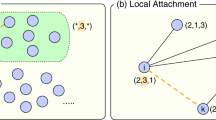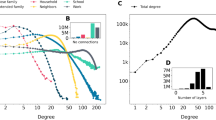Abstract
Data on the number of adults that an individual contacts at least once a month in a set of British populations yield estimates of network sizes that correspond closely to those of the typical “sympathy group” size in humans. Men and women do not differ in their total network size, but women have more females and more kin in their networks than men do. Kin account for a significantly higher proportion of network members than would be expected by chance. The number of kin in the network increases in proportion to the size of the family; as a result, people from large families have proportionately fewer non-kin in their networks, suggesting that there is either a time constraint or a cognitive constraint on network size. A small inner clique of the network functions as a support group from whom an individual is particularly likely to seek advice or assistance in time of need. Kin do not account for a significantly higher proportion of the support clique than they do for the wider network of regular social contacts for either men or women, but each sex exhibits a strong preference for members of their own sex.
Similar content being viewed by others
References
Bernard, H. R., P. D. Killworth, and L. Sailer 1982 Informant Accuracy in Social Network Data, V: An Experimental Attempt to Predict Actual Communication from Recall Data.Social Science Research 11:30–66.
1984 On the Validity of Retrospective Data: The Problem of Informant Accuracy.Annual Review of Anthropology 13:495–518.
Berté, N. 1988 K’ekchi’ Horticultural Labor Exchange: Productive and Reproductive Implications. InHuman Reproductive Behaviour, L. Betzig, M. Borgerhoff Mulder, and P. Turke, eds. Pp. 83–96. Cambridge: Cambridge University Press.
Bliezner, R. 1988 Individual Development and Intimate Relationships in Middle and Late Adulthood. InFamilies and Social Networks, R. M. Milardo, ed. Pp. 147–167. Newbury Park, California: Sage Publications.
Booth, A. 1972 Sex and Social Participation.American Sociology Review 37:183–192.
Bott, E. 1971Family and Social Network, revised edition. London: Tavistock Publications.
Brown, B. B. 1981 A Lifespan Approach to Friendship: Age-related Dimensions of an Ageless Relationship. InResearch in the Interweave of Social Roles, Vol. 2:Friendship, H. Z. Lopata and D. R. Maines, eds. Pp. 23–50. Greenwich, Connecticut: J. A. I.
Burt, R. S. 1982Towards a Structural Theory of Action: Network Models of Social Structure, Perceptions and Action. New York: Academic Press.
Buys, C. J., and K. K. Larsen 1979 Human Sympathy Groups.Psychology Reports 45:547–553.
Coleman, J. S. 1964Introduction to Mathematical Sociology. London: Collier-Macmillan.
Dunbar, R. I. M. 1992 Time: A Hidden Constraint on the Behavioural Ecology of Baboons.Behavioural Ecology and Sociobiology 31:35–49.
1993 Coevolution of Neocortex Size, Group Size and Language in Humans.Behavioral and Brain Sciences 16:681–735.
Dunbar, R. I. M., A. Clark, and N. L. Hurst 1995 Conflict and Cooperation among the Vikings: Contingent Behavioural Decisions.Ethology and Sociobiology, in press.
Firth, R., ed. 1956Two Studies of Kinship in London. London: Athlone Press.
Fischer, C. S. 1982To Dwell among Friends: Personal Networks in Town and City. Chicago: University of Chicago Press.
Foley, R., and P. C. Lee 1989 Finite Social Space, Evolutionary Pathways and Reconstructing Hominid Behavior.Science 243:901–906.
Foot, H. C., A. J. Chapman, and J. R. Smith 1980Friendship and Social Relations in Children. New York: Wiley.
Hames, R. B. 1979 Relatedness and Interaction among the Ye’kwana: a Preliminary Analysis. InEvolutionary Biology and Human Social Behavior, N. A. Chagnon and W. Irons, eds. Pp. 238–249. North Scituate, Massachusetts: Duxbury Press.
Hays, R. B., and D. Oxley 1986 Social Network Development and Functioning during a Lifetime Transition.Journal of Personality and Social Psychology 50:305–313.
Hughes, A. 1988Evolution and Human Kinship. Oxford: Oxford University Press.
Keesing, R. M. 1975Kin Groups and Social Structure. New York: Holt, Rinehart and Winston.
Killworth, P. D., H. R. Bernard, and C. McCarty 1984 Measuring Patterns of Acquaintanceship.Current Anthropology 25:391–397.
Knoke, D., and J. H. Kuklinski 1982Network Analysis. Beverly Hills, California: Sage.
Kudo, H., S. Bloom, and R. I. M. Dunbar 1995 Neocortex as a Constraint on Social Network Size in Primates. Submitted toBehaviour.
Larson, R. W., and N. Bradney 1988 Precious Moments with Family Members and Friends. InFamilies and Social Networks, R. M. Milardo, ed. Pp. 107–126. Newbury Park, California: Sage Publications.
Levinger, G., and A. C. Levinger 1986 The Temporal Course of Relationships and Development. InRelationships and Development, W. W. Hartup and Z. Rubin, eds. Pp. 111–133. London: LEA Press.
Levi-Strauss, C. 1969The Elementary Structures of Kinship. London: Eyre and Spottiswoode.
McCannell, K. 1988 Social Networks and the Transition to Motherhood. InFamilies and Social Networks, R. M. Milardo, ed. Pp. 83–106. Newbury Park, California: Sage Publications.
Milardo, R. M. 1988 Families and Social Networks: An Overview of Theory and Methodology. InFamilies and Social Networks, R. M. Milardo, ed. Pp. 13–47. Newbury Park, California: Sage Publications.
Milardo, R., ed. 1988Families and Social Networks. Newbury Park, California: Sage Publications.
Mitchell, J. C. 1969 The Concept and Use of Social Networks. InSocial Networks in Urban Situations, J. C. Mitchell, ed. Pp. 1–50. Manchester, England: Manchester University Press
Mitchell, J. C., ed. 1969Social Networks in Urban Situations. Manchester, England: Manchester University Press.
Rands, M. 1988 Changes in Social Networks following Marital Separation and Divorce. InFamilies and Social Networks, R. M. Milardo, ed. Pp. 127–146. Newbury Park, California: Sage Publications.
Rodseth, L., R. W. Wrangham, A. M. Harrigan, and B. B. Smuts 1991 The Human Community as a Primate Society.Current Anthropology 32:221–255.
Thorne, B. 1986 Girls and Boys Together … But Mostly Apart: Gender Arrangements in Elementary Schools. InRelationships and Development, W. W. Hartup and Z. Rubin, eds. London: LEA Press.
Young, M., and P. Willmott 1957Family and Kinship in East London. London: Routledge and Kegan Paul.
Author information
Authors and Affiliations
Additional information
Robin Dunbar, B.A., Ph.D., until recently a professor of biological anthropology at University College London, is professor of psychology at the University of Liverpool. His main research interests concern mating systems and the evolution of mammalian social systems. Matt Spoors, B.Sc., M.Sc., teaches at St Hugh’s School, Grantham (England).
Rights and permissions
About this article
Cite this article
Dunbar, R.I.M., Spoors, M. Social networks, support cliques, and kinship. Human Nature 6, 273–290 (1995). https://doi.org/10.1007/BF02734142
Received:
Accepted:
Issue Date:
DOI: https://doi.org/10.1007/BF02734142




